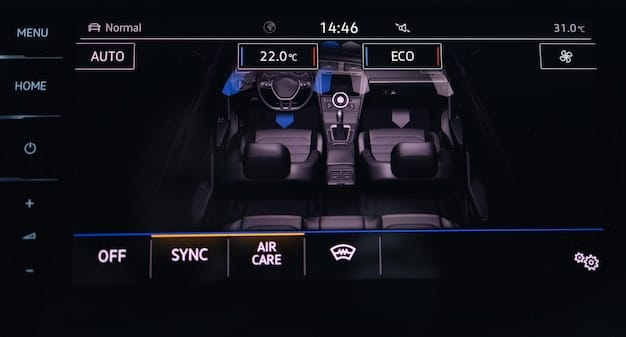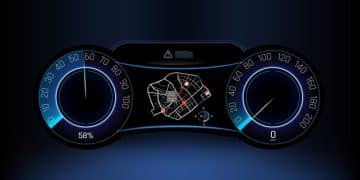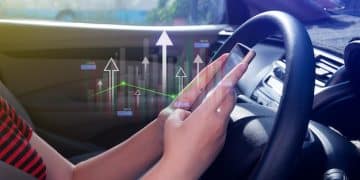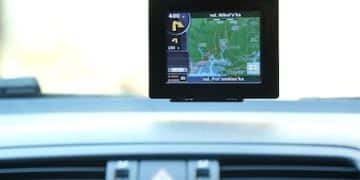The Future of Car Infotainment: Entertainment, Navigation, and Beyond

The future of car infotainment systems centers around seamless integration of entertainment, navigation, and vehicle controls, offering drivers personalized and intuitive experiences through advanced technologies like AI, augmented reality, and over-the-air updates.
The automotive industry is rapidly evolving, and at the heart of this transformation lies the car infotainment system. Welcome to a journey into the future of car infotainment systems: integrating entertainment and navigation, where technology enhances every aspect of the driving experience.
The Evolution of Car Infotainment Systems
Car infotainment systems have come a long way from simple radios. They’ve transformed into sophisticated hubs that offer a wide range of features. Let’s explore how these systems have evolved and what’s driving their future.
From Radio to Revolution
Initially, car infotainment was limited to basic AM/FM radios. Over time, features like cassette players and CD players were added. The real revolution began with the integration of digital technologies.
The Rise of Smart Integration
Today’s infotainment systems include GPS navigation, smartphone integration via Apple CarPlay and Android Auto, and access to various apps. This smart integration has become a key element in the driving experience.
- Enhanced Connectivity: Systems now offer seamless connectivity to smartphones and other devices.
- Advanced Navigation: GPS navigation has become more accurate and user-friendly.
- Entertainment Options: Streaming services and digital media provide a wealth of entertainment choices.
The future promises even more advanced features, like AI-powered assistants and augmented reality navigation, further blurring the lines between driving and digital life.

Key Trends Shaping the Future of Infotainment
Several key trends are shaping the future of car infotainment systems. These trends include the integration of artificial intelligence, enhanced connectivity, and personalized user interfaces. Let’s dive into each of these.
Artificial Intelligence (AI) Integration
AI is playing a larger role in infotainment systems, enabling voice-activated assistants, personalized recommendations, and predictive maintenance alerts. AI can learn driver preferences and adjust settings accordingly.
Enhanced Connectivity
With the advent of 5G and improved Wi-Fi capabilities, cars are becoming more connected than ever before. This enhanced connectivity enables real-time traffic updates, over-the-air software updates, and seamless streaming.
Personalized User Interfaces
Infotainment systems are increasingly offering personalized user interfaces. Drivers can customize the layout, choose their preferred apps, and set up profiles that cater to their individual needs.
These trends are transforming car infotainment from a simple entertainment source to a comprehensive command center.
Augmented Reality (AR) in Navigation
Augmented reality is set to revolutionize car navigation. By overlaying digital information onto the real world, AR navigation can provide drivers with more intuitive and safer guidance. Here’s how:
How AR Navigation Works
AR navigation uses cameras and sensors to capture a live video feed of the road ahead. This feed is then augmented with digital overlays, such as directional arrows, lane guidance, and points of interest.
Benefits of AR Navigation
AR navigation offers several benefits, including improved situational awareness, reduced driver distraction, and enhanced safety. By providing clear and intuitive guidance, AR can help drivers navigate complex roadways with ease.
- Improved Clarity: AR overlays provide clearer and more intuitive directions.
- Reduced Distraction: By keeping the driver’s focus on the road, AR minimizes distractions.
- Enhanced Safety: AR can highlight potential hazards and provide timely warnings.
AR navigation is poised to become a standard feature in future car infotainment systems, making driving safer and more enjoyable.
The Role of Over-the-Air (OTA) Updates
Over-the-air updates are crucial for keeping car infotainment systems up-to-date. OTA updates allow manufacturers to deliver new features, bug fixes, and security patches remotely, without requiring a visit to a service center.
Benefits of OTA Updates
OTA updates offer numerous benefits, including cost savings, convenience, and improved system performance. Drivers can enjoy the latest features and enhancements without any hassle.
How OTA Updates Work
OTA updates are typically delivered via a wireless connection, such as Wi-Fi or a cellular network. The system downloads the update in the background and prompts the driver to install it at a convenient time.

OTA updates are transforming the way car infotainment systems are maintained, ensuring they remain secure, reliable, and feature-rich.
Integrating Vehicle Controls into Infotainment Systems
The integration of vehicle controls into infotainment systems is becoming increasingly common. This trend allows drivers to manage various vehicle functions from a central interface, streamlining the driving experience. Let’s see how this happens:
Climate Control and Seat Adjustments
Many modern infotainment systems allow drivers to adjust climate control settings and seat positions directly from the touchscreen. This integration simplifies the process and eliminates the need for physical buttons.
Vehicle Diagnostics and Maintenance
Infotainment systems can also provide access to vehicle diagnostics and maintenance information. Drivers can monitor tire pressure, check oil levels, and receive alerts about potential issues.
- Centralized Control: Consolidate vehicle functions into a single interface.
- Streamlined Experience: Simplify the driving experience with easy-to-use controls.
- Real-Time Information: Provide access to important vehicle data.
By integrating vehicle controls, infotainment systems are becoming more than just entertainment hubs; they are evolving into comprehensive vehicle management systems.
Security and Privacy Considerations
As car infotainment systems become more connected and sophisticated, security and privacy concerns are growing. It’s essential to address these concerns to ensure that drivers’ data is protected. One way is to improve and protect the privacy.
Data Encryption and Cybersecurity
Manufacturers are implementing data encryption and cybersecurity measures to protect against hacking and data breaches. These measures include firewalls, intrusion detection systems, and regular security audits.
User Consent and Data Privacy
Drivers should have control over their data and be able to choose what information is collected and shared. Manufacturers should provide clear and transparent privacy policies and obtain user consent before collecting data.
Addressing security and privacy concerns is crucial for building trust and ensuring the long-term success of car infotainment systems.
| Key Feature | Brief Description |
|---|---|
| 🚗 AI Integration | Personalized recommendations, voice assistants, and predictive maintenance. |
| 🌐 Enhanced Connectivity | 5G, real-time updates, and seamless streaming capabilities. |
| 🗺️ AR Navigation | Augmented reality overlays for intuitive and safer guidance. |
| 🛡️ Security Measures | Data encryption and robust cybersecurity protocols. |
Frequently Asked Questions
▼
Future systems will offer AI-powered assistants, augmented reality navigation, enhanced connectivity with 5G, and personalized user interfaces, making the driving experience more intuitive and enjoyable.
▼
Augmented reality will overlay digital information onto the real world, providing drivers with clear directional arrows, lane guidance, and hazard warnings, improving safety and reducing distraction.
▼
OTA updates allow manufacturers to deliver new features, bug fixes, and security patches remotely, ensuring that the infotainment system remains up-to-date without requiring a visit to a service center.
▼
Manufacturers are implementing data encryption, firewalls, and intrusion detection systems to protect against hacking and data breaches, ensuring the security of user data and vehicle systems.
▼
Data privacy is being addressed through clear privacy policies, user consent mechanisms, and options for drivers to control what information is collected and shared, providing greater transparency and control.
Conclusion
The future of car infotainment systems is incredibly promising, with advancements in AI, AR, and connectivity set to revolutionize the driving experience. By focusing on security, privacy, and user personalization, manufacturers can create systems that are not only innovative but also trustworthy and enjoyable to use.





